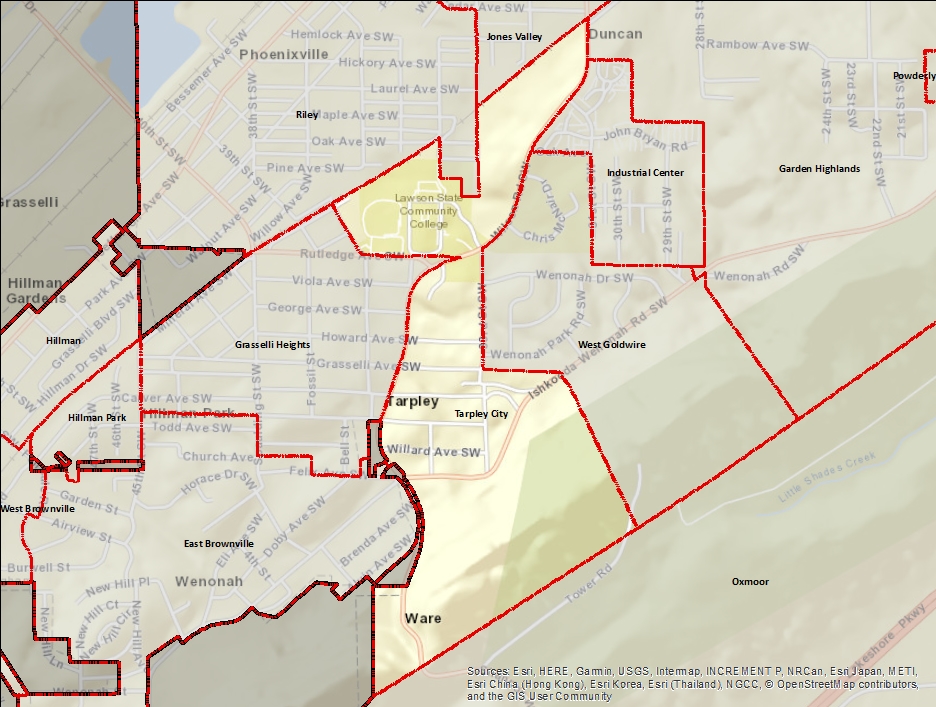Tarpley City
Tarpley City is a neighborhood in the Grasselli community of Birmingham. It lies between West Goldwire to the east and East Brownville and Grasselli Heights to the west on the north slope of Red Mountain, north of the Oxmoor neighborhood and south of the Jones Valley neighborhood. Originally one of a series of Red Mountain ore mining camps for employees of the Tennessee Coal and Iron Company (TCI) in the Wenonah area, Wenonah Camp #10 (1880-1952) was located adjacent to West Goldwire and south of the current Wenonah High School. The camp later became known as Tarpley City.
Indicator Details
| Indicators | Primary Domain | Indicator Value |
Rank |
Tier | Indicator Weight |
|---|---|---|---|---|---|
| Access to Mainstream Financial Services | Economic Health | 15.0% | 96 | Bottom | 1.00 |
| Land Use Mix | Neighborhood Characteristics | 0.1 | 92 | Bottom | 1.00 |
| Reading Proficiency | Educational Opportunities | 6.0% | 89 | Bottom | 3.00 |
| Tax Delinquent Properties | Blight | 29.0% | 86 | Bottom | 5.00 |
| Long-Term Unemployment | Employment Opportunities | 5.3% | 84 | Bottom | 1.00 |
| Public Assisted Households | Employment Opportunities | 64.1% | 83 | Bottom | 1.00 |
| Local Business Vitality | Economic Health | 44.4% | 81 | Bottom | 1.00 |
| Residential Mobility | Social Cohesion | 75.5% | 73 | Bottom | 1.00 |
| Pedestrian Connectivity | Transportation | 56 | 71 | Bottom | 4.00 |
| Motor Vehicle Collisions | Health Systems and Public Safety | 9.4 | 70 | Bottom | 4.00 |
| Household Transportation Costs | Transportation | 26.1% | 67 | Bottom | 4.00 |
| Violent Crime | Health Systems and Public Safety | 117.4 | 65 | Middle | 4.00 |
| Age of Housing | Housing | 87.8% | 65 | Middle | 1.00 |
| Visual Property Nuisances | Blight | 18.2% | 62 | Middle | 5.00 |
| Employment Rate | Employment Opportunities | 83.0% | 60 | Middle | 1.00 |
| Walkability | Neighborhood Characteristics | 45 | 57 | Middle | 4.00 |
| Travel Time to Work | Employment Opportunities | 25.3 | 56 | Middle | 1.00 |
| Chronic School Absence | Health Systems and Public Safety | 26.2% | 55 | Middle | 1.00 |
| Infant Mortality Rate | Health Systems and Public Safety | 12.8 | 49 | Middle | 1.00 |
| Food Desert | Neighborhood Characteristics | 80.0% | 44 | Middle | 2.00 |
| Excessive Housing Cost Burden | Housing | 37.1% | 41 | Middle | 1.00 |
| Toxic Releases from Facilities | Environmental Hazards | 68.8% | 39 | Middle | 1.00 |
| Adult Educational Attainment | Educational Opportunities | 82.0% | 34 | Middle | 3.00 |
| Transit Accessibility | Transportation | 6 | 33 | Top | 4.00 |
| Public Health Nuisances | Health Systems and Public Safety | 37.6 | 23 | Top | 4.00 |
| Commute Mode Share | Transportation | 25.3% | 23 | Top | 4.00 |
| Voter Participation | Social Cohesion | 7.5% | 20 | Top | 1.00 |
| Abandoned Structures | Blight | 5.0% | 20 | Top | 5.00 |
| Preschool Enrollment | Educational Opportunities | 43.4% | 19 | Top | 3.00 |
| Tree Cover | Natural Areas | 36.3% | 16 | Top | 1.00 |
| Vacancy Rates | Housing | 9.9% | 14 | Top | 1.00 |
| Business Retention | Economic Health | 12.5% | 13 | Top | 1.00 |
| Payday Loans | Economic Health | 0 | 1 | Top | 1.00 |
| Pedestrian & Bicycle Injuries by Motor Vehicles | Health Systems and Public Safety | 0 | 1 | Top | 4.00 |
| Residential Proximity to Traffic | Environmental Hazards | 0.0% | 1 | Top | 1.00 |
| Proximity to Brownfield Sites | Environmental Hazards | 0.0% | 1 | Top | 1.00 |
| School Proximity to Traffic | Environmental Hazards | 0.0% | 1 | Top | 1.00 |
| Proximity to Superfund Sites | Environmental Hazards | 0.0% | 1 | Top | 1.00 |
| Offsite Alcohol Outlets | Neighborhood Characteristics | 0 | 1 | Top | 1.00 |
| Access to Parks and Open Space | Natural Areas | 100.0% | 1 | Top | 1.00 |
| High School Graduation Rate | Educational Opportunities | 85.9% | 1 | Top | 3.00 |
| Preventable Hospitalizations | Health Systems and Public Safety | - | - | Data N/A | 1.00 |
| Blood Lead Levels in Children | Housing | -% | - | Data N/A | 1.00 |
| Low Birth Weight | Health Systems and Public Safety | -% | - | Data N/A | 1.00 |
| School Readiness Scores | Educational Opportunities | -% | - | Data N/A | 1.00 |

Demographic and Contextual Indicators
| Neighborhood | City Wide | |
|---|---|---|
| Income Inequality | 0.6 | 0.49 |
| Concentrated Poverty | 40.4% | 30.9% |
| Life Expectancy | 73 | 78.8 |
| Population | 213 | 210,616 |
| Racial and Ethnic Diversity | 0.5 | 0.44 |
| Park Quality | 54.2 |